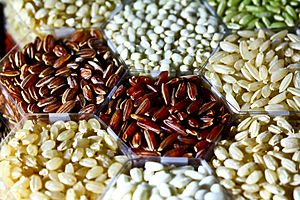Mutation breeding facts for kids
Mutation breeding is a way to create new kinds of plants. It is also called variation breeding. This process involves exposing plant seeds to special chemicals or radiation. This makes small changes, called mutations, happen in the seeds.
These changed seeds can then grow into plants with new features. Scientists can also cross these plants with other plant types, called cultivars. This helps them get useful new traits, like stronger plants or bigger fruits. Plants made this way are sometimes called mutagenic plants.
Contents
What is Mutation Breeding?
Mutation breeding helps scientists find new and useful traits in plants. It speeds up the natural process of change.
- How it works: Seeds are treated with things like X-rays or certain chemicals. These treatments cause tiny changes in the plant's DNA.
- Why it's done: These changes can lead to new features. For example, a plant might become more resistant to diseases. It could also grow faster or produce more food.
- Finding new traits: After treatment, scientists grow the seeds. They then look for plants with the desired new traits. These special plants are chosen for further breeding.
History and Impact of Mutant Plants
Mutation breeding has been used for a long time to improve many plants. It has helped create thousands of new plant types.
- Many new varieties: Between 1930 and 2014, over 3,200 new types of plants were created using this method.
- Direct changes and offspring: About 70% of these plants were direct mutants. This means they grew directly from the treated seeds. The other 30% were offspring from these direct mutant plants.
- Food and decorative plants: Most of these new plants (about three-quarters) are crop plants. These are plants grown for food, like rice or wheat. The rest are ornamental plants, which are grown for their beauty.
- Worldwide use: In 2014, organizations like the FAO and the IAEA reported that over 1,000 types of important staple crops were grown worldwide using this method.
How Mutation Breeding Helps Us
This method helps farmers grow better crops and provides more food for people.
- Stronger plants: Some mutant plants can resist diseases better. Others might need less water.
- Better food: Mutation breeding can lead to crops with higher nutritional value. It can also make crops that are easier to harvest.
- Adapting to challenges: As the world changes, new plant varieties are needed. Mutation breeding helps create plants that can grow in different climates or soils.
See also
 In Spanish: Mejoramiento por mutación para niños
In Spanish: Mejoramiento por mutación para niños


